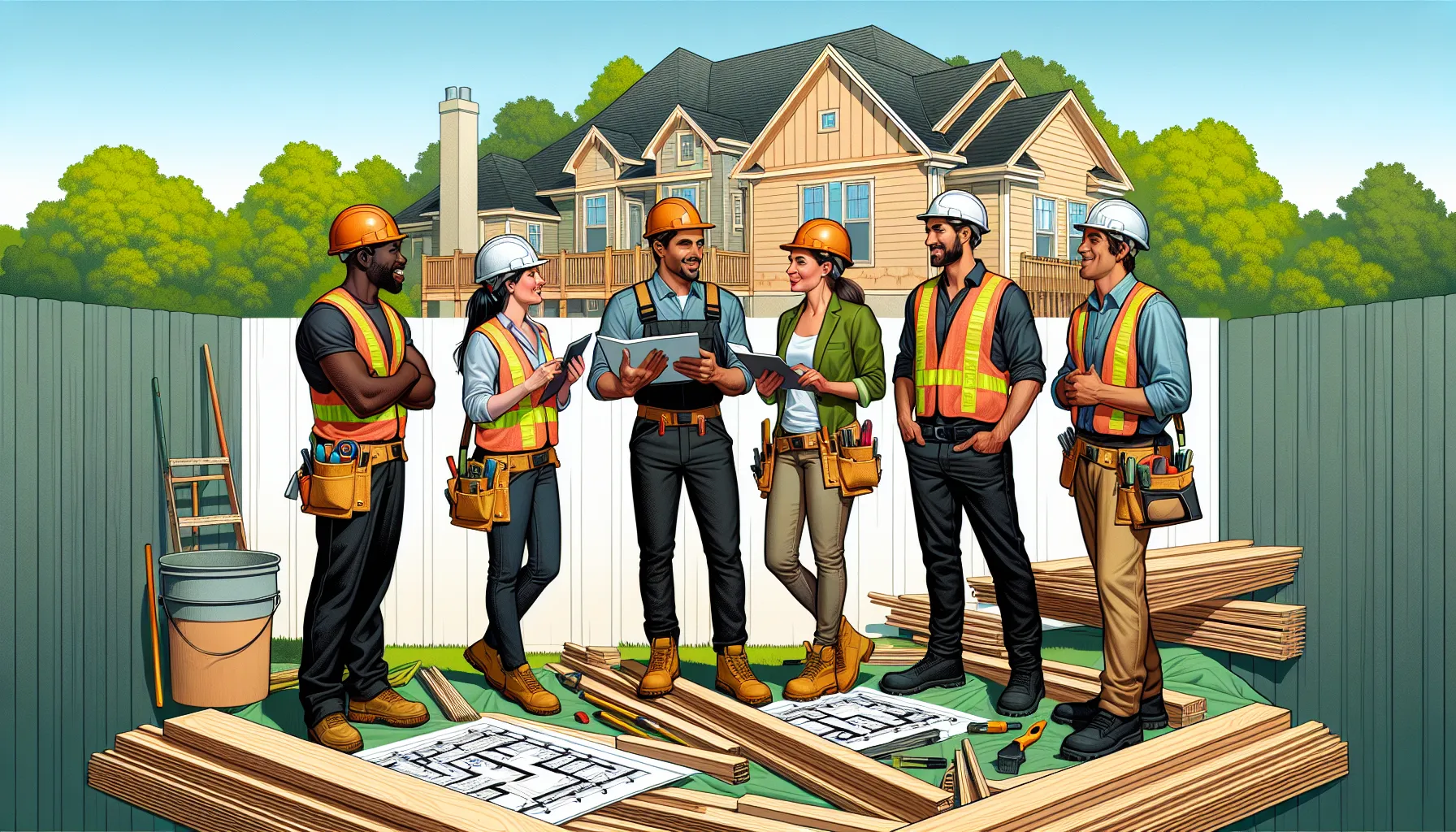Key Takeaways
- Average Cost Insights: The average cost to build a house in North Carolina for 2025 ranges significantly based on location—urban areas like Charlotte and Raleigh are more expensive compared to rural counties.
- Cost Influencers: Key factors affecting construction costs include land purchase prices, material expenses, and labor rates, with urban areas typically commanding higher prices.
- Regional Variability: Costs can vary drastically between urban and rural settings, with urban lots averaging $150,000 to $300,000, while rural lots may only range from $30,000 to $80,000.
- Additional Expenses: Potential homeowners should consider additional costs such as permits (ranging from $1,000 to $3,000) and utility connections (averaging $5,000 to $15,000) to ensure a comprehensive budget.
- Future Trends: Anticipated trends suggest rising construction costs in urban areas, driven by population growth, while technological advancements and sustainability practices may offer innovative cost-saving solutions.
- Labor Market Dynamics: Increasing wages for construction workers due to labor shortages could impact overall project budgets, necessitating careful financial planning.
Building a house is an exciting journey, but understanding the costs involved can feel overwhelming. In North Carolina, the average cost to build a house in 2025 is influenced by various factors, from location to materials and labor. As we dive into this topic, we’ll explore what you can expect to spend and how these costs compare to national averages.
Whether you’re a first-time homebuyer or looking to invest, knowing the financial landscape is crucial. We’ll break down the essentials, helping you navigate expenses while making informed decisions. Join us as we uncover the key elements that shape construction costs in the Tar Heel State, ensuring you’re well-prepared for your building adventure.
Overview of Housing Market in North Carolina
The housing market in North Carolina reflects a dynamic blend of demand, supply, and economic factors. Home prices, generally rising, are influenced by urban growth and varying demand across regions. In 2025, we anticipate average home prices will vary significantly, with urban centers like Charlotte and Raleigh experiencing higher price points compared to rural areas.
Affordability remains a key concern for many potential homeowners. Though interest rates fluctuate, the availability of mortgage options continues to help buyers enter the market. We observe that the integration of technology in real estate transactions has streamlined processes, making it easier for buyers and sellers to navigate the complexities involved in purchasing a home.
Regional factors contribute to the diversity within the North Carolina housing market. The coastal regions attract retirees and vacation home seekers, while the mountainous areas draw those seeking a quieter lifestyle. Each area presents unique opportunities and challenges for buyers, given local economic conditions and demographic trends.
Demand for new construction houses also reflects the growing population. Builders are responding by offering various styles and price points to cater to different buyer segments. Understanding these trends is crucial for making informed decisions regarding home purchases and investments.
As we consider entering this evolving market, potential homeowners must weigh their options carefully. What are the trade-offs between location preferences and budget constraints? By focusing on key indicators, we can better navigate the complexities of homebuilding costs and housing availability in North Carolina’s diverse market landscape.
Factors Influencing Construction Costs

Understanding the factors influencing construction costs provides clarity as we plan our new homes in North Carolina. Key elements such as land purchase costs, material expenses, and labor rates significantly impact our overall budget.
Land Purchase Costs
Land purchase costs serve as the foundation of any construction project. According to the North Carolina Association of Realtors, prices vary widely based on location, with urban centers demanding higher prices than rural areas. For instance, average lot prices in Charlotte can reach upwards of $150,000, while similar lots in smaller towns may only cost $40,000. Proximity to amenities, schools, and job opportunities also influences land prices. We must weigh these location factors against our financial capacity to ensure a wise investment.
Material Costs
Material costs play a crucial role in determining our total construction expenditure. In North Carolina, the prices for essential building materials, including lumber, drywall, and concrete, have fluctuated due to supply chain issues and market demand. For example, lumber prices soared by more than 50% in the last two years, impacting many builders’ budgets. Recent trends indicate that opting for energy-efficient materials may add initial costs but offer long-term savings on utilities. Choosing the right materials requires careful consideration to balance quality and affordability while meeting our sustainability goals.
Labor Costs
Labor costs are another significant factor in construction expenses. In North Carolina, the average hourly wage for construction workers hovers around $25, with variations depending on skill level and trade. For example, carpenters and electricians may demand higher wages due to their specialized skills. The overall labor market remains competitive, influencing project timelines and budgets. As we embark on our homebuilding journey, evaluating labor rates and experienced professionals can ensure smooth progress and adherence to our financial limits.
Each of these factors presents distinct challenges and opportunities that we encounter on our building journey. Thoughtful consideration of costs today lays the groundwork for a home that meets our needs and reflects our values.
Average Cost Breakdown by County

Understanding the average cost to build a house in North Carolina varies significantly by county. This section breaks down these costs to provide clarity for potential homeowners, builders, and investors.
Urban vs. Rural Areas
Urban and rural areas in North Carolina show noticeable disparities in building costs. Urban counties like Mecklenburg and Wake typically feature higher land prices, averaging $150,000 to $300,000 for a standard lot. In contrast, rural counties such as Ashe or Swain offer lots ranging from $30,000 to $80,000. Labor rates also differ; urban contractors might charge $30 per hour compared to $20 in rural settings. These factors contribute to overall construction costs, which can range from $250,000 in rural areas to over $500,000 in urban environments with high demand. As we evaluate options, weighing location preferences against these costs becomes essential.
Major Cities Comparison
In major cities, building costs reflect local trends and market demands. In Charlotte, the average cost to build a house stands around $375,000, with premium materials and modern amenities. Raleigh follows close behind, averaging $350,000, driven by a mix of new construction and established neighborhoods. Conversely, cities like Greensboro and Winston-Salem see lower averages, around $275,000, appealing to first-time buyers and those seeking affordability. Factors such as school districts, proximity to amenities, and local economy shape these price points. Recognizing these variances helps us align our building budget with our desired city, ensuring clarity in our decision-making process.
Additional Expenses to Consider
Building a house in North Carolina involves various additional expenses that can significantly impact the overall budget. Understanding these costs ensures we adequately prepare for the financial commitments of home construction.
Permits and Fees
Permits and fees represent essential costs associated with building a house. The average cost for permits in North Carolina can range from $1,000 to $3,000 depending on the project’s scope and location. Local jurisdictions require different permits for zoning, building, electrical, plumbing, and mechanical work. We must account for these charges early in the budgeting process to avoid unexpected expenses. Projects in urban centers often incur higher fees due to stricter regulations. Checking with local governments for accurate permit requirements and associated costs ensures that we stay compliant and can help avoid costly delays.
Utility Connections
Utility connections include fees for water, sewer, gas, and electric services, which form a critical part of home construction expenses. The average cost to connect utilities can vary, costing anywhere from $5,000 to $15,000 based on location and accessibility. Proximity to existing utility lines can impact these costs, and urban areas tend to have more established infrastructure compared to rural regions. We must factor in not just the connection fees but also the potential cost of extending utilities if the home site isn’t already serviced. Understanding these factors contributes to a comprehensive financial plan when building a house, ensuring that we allocate sufficient funds for necessary connections.
Future Trends in Home Construction Costs
Anticipated shifts in home construction costs for North Carolina highlight unique regional dynamics. We expect fluctuations driven by increased demand from a growing population in urban areas like Charlotte and Raleigh. These cities may see construction costs rise by 5% to 10% annually as demand for housing outpaces supply. Monitoring these trends helps potential homeowners prepare financially and strategically.
Technological advancements are likely to influence construction costs significantly. The adoption of 3D printing and modular homes offers cost-effective solutions, potentially reducing expenses by 20% to 30%. Such innovations could change our approach to building, making it more efficient. Builders embracing these technologies may attract first-time homebuyers looking for affordable options.
Sustainability trends continue shaping the construction landscape. As energy-efficient materials gain popularity, initial costs may rise, but long-term savings on utility bills follow. Builders using eco-friendly practices might see a boost in demand, as buyers increasingly value sustainability. This shift encourages us to consider both upfront investments and the lasting impact on our finances.
Furthermore, labor market trends influence construction costs directly. With construction worker wages expected to rise due to labor shortages, budget planning must account for these increases. Expect to adjust project budgets for labor rates, which could see growth of 3% to 5% each year. Evaluating labor availability in specific areas aids us in anticipating potential cost changes as projects progress.
Economic factors, including inflation rates and supply chain stability, also play essential roles. Rising inflation increases material costs, impacting overall construction budgets. Monitoring regional economic health provides insight into future price changes. Awareness of both national and local economic conditions helps us anticipate shifts and make informed decisions.
Conclusion
As we consider the average cost to build a house in North Carolina in 2025 it’s clear that understanding the various influences on these expenses is crucial for anyone looking to enter the market. With rising home prices and fluctuating material costs we need to remain informed about regional differences and emerging trends.
By carefully evaluating our budgets and aligning them with location preferences we can navigate this evolving landscape. The integration of technology and sustainable building practices offers promising avenues for cost savings. Staying ahead of these trends will empower us to make smarter decisions as we embark on our homebuilding journeys in North Carolina.
Frequently Asked Questions
What factors influence the costs of building a house in North Carolina in 2025?
Several factors impact the costs, including location, material expenses, and labor rates. Urban areas like Charlotte have higher land prices and labor costs compared to rural regions. Additionally, current supply chain issues can affect material costs.
How much can I expect to pay for land in North Carolina?
Land costs vary widely depending on location. In urban counties like Mecklenburg and Wake, prices can range from $150,000 to $300,000, while rural counties like Ashe or Swain may offer prices between $30,000 and $80,000.
What are the average construction costs in major North Carolina cities?
In major cities, construction costs vary significantly. Charlotte averages around $375,000, Raleigh at $350,000, and Greensboro or Winston-Salem offer more affordable options at approximately $275,000.
Are there additional expenses I should consider when building a house?
Yes, expect additional costs for permits and fees, which can range from $1,000 to $3,000. Utility connection fees typically vary between $5,000 and $15,000 depending on location and accessibility.
How do future trends impact construction costs in North Carolina?
Future trends suggest construction costs may rise by 5% to 10% annually due to increased urban demand. Technological advancements and sustainability practices might provide cost-effective solutions, potentially reducing expenses by 20% to 30%.
What should first-time homebuyers know about the housing market?
First-time homebuyers should be aware of rising home prices and the varying costs associated with urban versus rural areas. Understanding mortgage options and budgeting for construction costs is crucial for making informed decisions.
How do labor costs differ between urban and rural areas?
Labor costs generally vary significantly, with urban contractors charging around $30 per hour, compared to about $20 for rural settings. This disparity affects overall building expenses and must be factored into the budget.
What role does technology play in home construction costs?
Technology, such as 3D printing and modular homes, is helping to reduce expenses and streamline the building process. These innovations are expected to offer significant cost savings while improving efficiency in construction.






